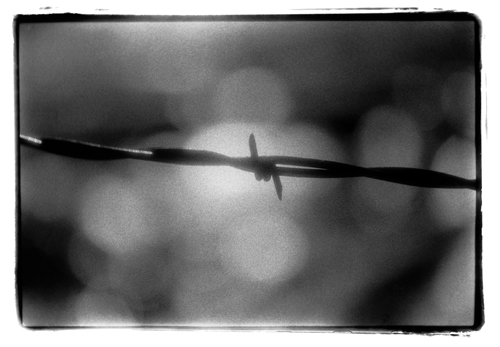By Signe Predmore
Northwest Asian Weekly

During the Japanese internment at Minidoka, photographs of the barbed wire surrounding the camp were forbidden.
When President Bill Clinton designated the Minidoka War Relocation Center in Idaho as a National Park in 2001, Teresa Tamura realized that although she grew up not three hours away from the site, she knew little about it.
Tamura, a Sansei (third generation Japanese American) and photojournalist from Nampa, Idaho, is too young to have witnessed the period of West Coast Japanese incarceration during World War II firsthand. And she never heard it discussed by elders in her own family, who were not interned themselves. A college professor at Idaho State had once urged her to visit Minidoka, where many Japanese and Japanese Americans from the Pacific Northwest were held. However, at the time, the suggestion made her “feel uncomfortable and self-conscious.”
Tamura did finally make the journey to the site after the National Park designation, and it quickly captured her attention. “What happened to the people who lived there? Could photographs prevent something like this from happening again?” she wondered.
Tamura began an 11-year project that culminated in the publication of her photography book, “Minidoka: An American Concentration Camp,” last year. A combination of archival photos and Tamura’s own recent shots, the book is a detailed and well-researched historical document that transcends its accessible coffee-table format.
“Minidoka” contains absorbing images of the campsite, as well as artifacts associated with it, but portraits are really at its heart. They were also the solution to the problem of how to depict a time and place that existed over 50 years ago.
“It wasn’t the kind of project where you jot ideas of what you can photograph,” Tamura said. “When I finally did go to the site, I was so disappointed because there really wasn’t much there.”
It was the people who had been interned at Minidoka that provided a living link to the history of the place. Throughout the book, Tamura juxtaposes an image from a moment in life at the camp — births, deaths, marriage, funerals, education, people at rest, and children at play — with a portrait she took of the same individuals after 2001. She often gives a brief written summary of their lives after the camp.
For the present-day photos, Tamura said, “I started asking people to think about Minidoka [while I took] the portraits, and in the beginning I didn’t, and I can really see the difference in expressions of people.”
This simple presentation is surprisingly powerful. It is hard not to be impressed by all those who went on to live lives of quiet dignity and productive citizenship, despite years of discrimination and incarceration by the government of their adopted country.
Some of the archival photographs Tamura includes are well-known images from the time, such as that of Fumiko Hayashida and her 1-year-old daughter being forcefully removed from Bainbridge Island. Many others were originally uncaptioned, or in some cases, people had been identified by the wrong names, so Tamura faced the challenge of trying to figure out who they were.
This work was time-consuming, but makes her book an invaluable contribution to the historical record. For instance, one photo shows three young boys eating hot dogs in the Minidoka mess hall. Tamura had seen the image reproduced in many books without the subjects ever identified. After a long search involving a combination of informants, correspondence, and a chance reading of an obituary, she finally learned their names were Taro Ogawa and the Hirai brothers, Tom and Gordon.
The number of images from the time of internment is limited. Japanese in America were outlawed from keeping cameras during the war, though some did make their way into the camps at different times. The non-Japanese professional photographers who were given permission to take pictures of the camps, including Dorothea Lange and Ansel Adams, were forbidden from showing barbed wire, watchtowers, or armed guards, as Tamura writes. She chose the cover image for the book, a close-up of a single barb of wire, in direct response.
“It seemed important to have a picture of barbed wire, so I photographed it against a regular dirt background, and it was too similar in tone,” said Teresa. “I needed a photograph where there was some contrast, so I waited until there was snow on the ground, and it still wasn’t right,” she said.
“And then the National Park Service started putting up signage that talked about the soothing water in the canal, and how the people who were there really gravitated towards the canal because it represented freedom and it could move through the area. That really resonated with me, and I thought, it has to be the combination of the barbed wire and the freedom of the canal.”
“Minidoka” has been warmly received by the public. “I’ve been really surprised and grateful at the interest from not only the Japanese American community, but also the community at large,” said Tamura. In sharing the work, she’s heard new stories from white citizens who lived in the area at the time and have come forward with their own memories of the camp from an outside perspective.
Now that the book is finished, Tamura is considering a career change. Her research on Minidoka exposed her to the variety of ways that former camp residents have dealt psychologically with the experience. She applied and was accepted into a training program for art therapists, and is currently debating whether to enroll. But whether she begins this new path or not, Tamura says she will continue to pursue her lifelong passion for photography. “My love for photography is something I don’t want to lose,” she said. (end)



